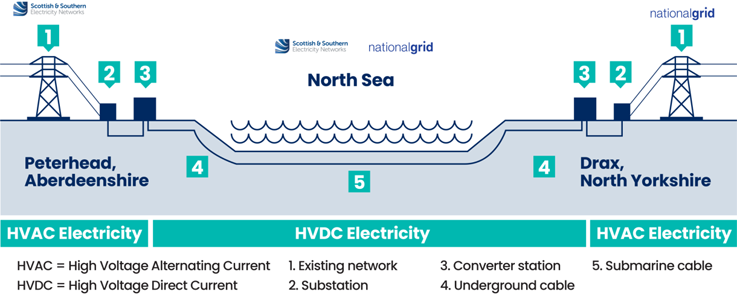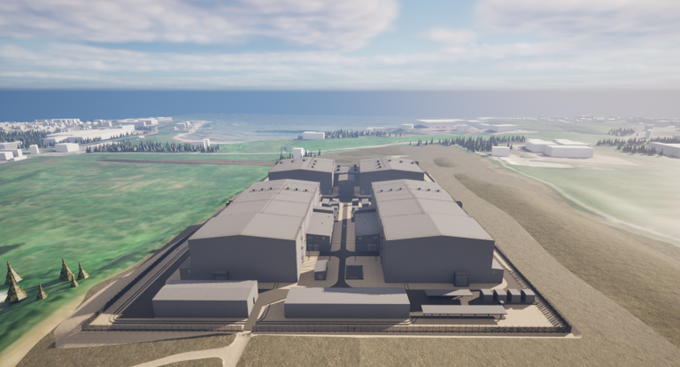
Eastern Green Link 2 (known as EGL2) is one of the most significant strategic energy infrastructure developments the UK has seen in recent years, connecting the north of Scotland to Yorkshire via the sea.
EGL2 is a 505km electricity superhighway which will enable the transfer of power from Scotland to England (and vice versa) via a subsea cable. This two-gigawatt high voltage direct current (HVDC) cable is connecting Peterhead in Aberdeenshire and Drax in North Yorkshire and once operational, will carry enough electricity to power two million homes.

Computer generated visual of Wren Hall Converter Station
EGL2 will scale up the UK’s capacity to transport home-produced clean energy, predominantly from offshore wind, from where it is generated to where there is demand. By doing so it will increase the security, resilience, and stability of the UK’s transmission network.
At an investment of over £4bn, EGL2 is the largest ever single investment in the UK transmission system and will play a critical role in delivering the UK and Scottish governments’ clean power and energy security targets, supporting thousands of jobs across the country and boosting local and national economies.

Computer generated visual of Peterhead Converter Station
This project is a major step forward in delivering the reliability and security of the UK's home-grown energy supply and will provide greater flexibility to balance electricity demand and supply, enhance energy resilience, and help us to future-proof the network against rising energy needs.
EGL2 is being delivered as a joint venture between SSEN Transmission and National Grid Electricity Transmission (NGET). NGET owns and manages the electricity transmission network in England and Wales, and SSEN Transmission does the same in the north of Scotland. The two connection points of EGL2 fall within these operating areas.
Following final approval from Ofgem in August 2024, construction for EGL2 is now underway and the project is due to be operational in 2029.
Needs case
Peterhead in Aberdeenshire, Scotland, and Drax in North Yorkshire, England, are both key hubs in the UK's energy landscape. Peterhead is an area that is becoming a hub for renewable energy generation, particularly from offshore wind, and Drax hosts a National Grid substation and overhead line infrastructure.
EGL2 is a critical component of the broader energy strategy for England and Wales. It is part of The Great Grid Upgrade, the largest overhaul of the electricity network in generations which aims to prepare the electricity network for a Net Zero future.
Pathway to 2030 is an equivalent blueprint for electricity transmission upgrades led by SSEN Transmission in Scotland. This scheme involves a further series of projects to increase capacity in the electricity transmission network in Scotland, to help meet UK and Scottish offshore wind targets of 50 GW and 11 GW respectively.
The project also supports the need for the UK to upgrade its electricity infrastructure helping to meet the challenges we face due to:
- Energy decarbonisation – as the UK continues to phase out fossil fuels, the electricity network must be capable of delivering energy from low carbon and renewable forms of generation, including offshore wind, to homes and businesses across the country
- Energy security – connecting the network to home-grown sources of generation will help to ensure our electricity network is self-sufficient and less reliant on imports
- Increasing demand – electricity demand in the UK is forecasted to double by 2050, meaning EGL2 is crucial to ensuring that the network can supply homes and businesses.
EGL2 is a collaborative effort with thousands of people from a range of organisations - big and small - working together to build the project. Of these organisations, there are three main works contractors which have responsibility for the delivery of EGL2 key infrastructure:
Hitachi Energy, a global leader in power technologies, is responsible for delivering the HVDC technology at our converter stations that will enable efficient long-distance bi-directional electricity transmission between Scotland and England.
BAM is an international construction and civil engineering company with extensive experience in delivering complex infrastructure projects. As a key contractor on EGL2, BAM is responsible for overseeing the construction of the converter stations at Peterhead and Wren Hall.
Prysmian is a global cable solutions provider leading the energy transition and digital transformation. On EGL2, Prysmian is responsible for the cable system design, manufacturing, and installation of the 436 km subsea cable, as well as the 69 km onshore underground cable in England and Scotland. To support the installation of EGL2’s onshore underground cable, Balfour Beatty has been subcontracted by Prysmian to deliver this key component of the project.
 KEYFACT Energy
KEYFACT Energy